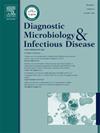预测重症监护病房脑梗死患者脓毒症风险的Nomogram和随机生存森林模型。
IF 2.1
4区 医学
Q3 INFECTIOUS DISEASES
Diagnostic microbiology and infectious disease
Pub Date : 2025-01-06
DOI:10.1016/j.diagmicrobio.2025.116678
引用次数: 0
摘要
背景:构建nomogram和随机生存森林(RSF)模型预测重症监护病房(icu)脑梗死患者脓毒症的发生。方法:从重症监护医学信息市场数据库2.0版(MIMIC-IV v2.0)中纳入1963例患者。基于Cox回归和Lasso回归对nomogram和RSF建模的特征筛选。结果:患者按7:3的比例随机分为训练集(1374例)和验证集(589例)。图模型中的危险因素包括阿替洛尔、碳酸氢盐、钙、氯吡格雷、双嘧达莫、心力衰竭、淋巴细胞百分比、咪达唑仑、异丙酚、横纹肌溶解、万古霉素、白细胞和抗生素。在训练集和验证集中,nomogram预测入院第3天脓毒症的AUC分别为0.798和0.765,预测第7天脓毒症的AUC分别为0.808和0.736。在训练集和验证集中,RSF模型预测入院第3天脓毒症的AUC分别为0.899和0.775,预测第7天脓毒症的AUC分别为0.913和0.768。结论:两种模型均能可靠地预测重症监护室脑梗死患者脓毒症的发生概率,有助于临床医生评估病情,及时为患者提供医疗干预。RSF模型具有更好的性能。本文章由计算机程序翻译,如有差异,请以英文原文为准。
Nomogram and randomized survival forest model for predicting sepsis risk in patients with cerebral infarction in the intensive care unit
Background
To construct a nomogram and a Randomized Survival Forest (RSF) model for predicting the occurrence of sepsis in patients with cerebral infarction in intensive care units (ICUs).
Methods
A total of 1,963 patients were included from the Medical Information Mart for Intensive Care IV database version 2.0 (MIMIC-IV v2.0). Screening features based on Cox regression and Lasso regression for nomogram and RSF modeling.
Results
Patients were randomly split into a training set (1,374 cases) and a validation set (589 cases) at a ratio of 7:3. Risk factors in the nomogram model included atenolol, bicarbonate, calcium, clopidogrel, dipyridamole, heart failure, lymphocyte percent, midazolam, propofol, rhabdomyolysis, vancomycin, white blood cells, and antibiotics. In the training and validation sets, the nomogram predicted sepsis on the 3rd day of admission with an AUC of 0.798 and 0.765 and predicted sepsis on the 7th day with an AUC of 0.808 and 0.736, respectively. In the training and validation sets, the RSF model predicted sepsis on the 3rd day of admission with an AUC of 0.899 and 0.775 and predicted sepsis on the 7th day with an AUC of 0.913 and 0.768, respectively
Conclusions
The two models can reliably predict the probability of sepsis in patients with cerebral infarction in the intensive care unit, which can help clinicians to assess the condition and provide timely medical interventions for patients. The RSF model has better performance.
求助全文
通过发布文献求助,成功后即可免费获取论文全文。
去求助
来源期刊
CiteScore
5.30
自引率
3.40%
发文量
149
审稿时长
56 days
期刊介绍:
Diagnostic Microbiology and Infectious Disease keeps you informed of the latest developments in clinical microbiology and the diagnosis and treatment of infectious diseases. Packed with rigorously peer-reviewed articles and studies in bacteriology, immunology, immunoserology, infectious diseases, mycology, parasitology, and virology, the journal examines new procedures, unusual cases, controversial issues, and important new literature. Diagnostic Microbiology and Infectious Disease distinguished independent editorial board, consisting of experts from many medical specialties, ensures you extensive and authoritative coverage.

 求助内容:
求助内容: 应助结果提醒方式:
应助结果提醒方式:


